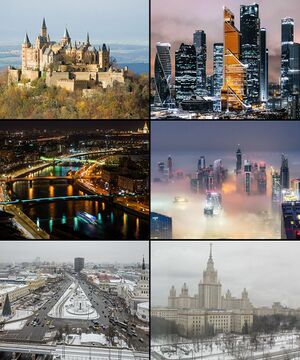Debrecen
This article is incomplete because it is pending further input from participants, or it is a work-in-progress by one author. Please comment on this article's talk page to share your input, comments and questions. Note: To contribute to this article, you may need to seek help from the author(s) of this page. |
Debrecen
Ruvelkan: Úìǔṷìūìṵ | |
|---|---|
Capital City District Capital | |
 Clockwise from top: Prohászka Citadel; Ruvelka's International Business District; Downtown Debrecen shrouded in fog; Ruvelka State University; Keresztes Terminal Square; Bridges over Válicka River. | |
| Country | |
| District | Debrecen District |
| Founded | 1022 CE |
| Government | |
| • Body | Debrecen Assembly |
| • Chancellor | Márk Fehér |
| Area | |
| • Total | 2,323.5 km2 (897.1 sq mi) |
| Elevation | 2,538 m (8,327 ft) |
| Highest elevation | 2,951 m (9,682 ft) |
| Population (2019) | |
| • Total | 8,645,002 |
Debrecen (Ruvelkan Script: Úìǔṷìūìṵ) is the capital of Ruvelka, the capital of the Debrecen District, and the nation’s most populous city with a current population of 8,645,002. Since the 14th century, Debrecen has been a major center of finance and commerce in the region as it is located on one of the easier to traverse routes through the Kurilla Mountains—as a result it is also a key railway, highway, and air-transport hub. The Debrecen Metro, which was opened in 1941 post-Siduri War, is also known as one of the busiest metro systems in Siduri.
Established as a fortress for the Prohászka family, Debrecen was strategically located atop the Kurilla Plateau adjacent to Lake Válicka. Over time, it grew to become a powerful and prosperous city that would serve as the capital of the Principality that would bear its namesake. The Arkoennite Empire used Debrecen as its administrative headquarters for the region until its eventual collapse in the 1700s at which point the Prohászkas had begun reconsolidating their power and reforming the Principality of Debrecen. It was a major proponent of Ruvelkan unification and became the capital of the Ruvelkan Imperium following its foundation.
The capital of Ruvelka was moved to Kaposvár following the conclusion of the Red War that created the Ruvelkan Socialist Republic. The leaders of the National Communist Party of Ruvelka did not want to associate the new government with the former Imperium, although Debrecen’s size and cultural importance meant that it was never overshadowed by Kaposvár. Debrecen later became the capital of Ruvelka again in the aftermath of the Ruvelkan Civil War and remains the capital city of the contemporary Grand Principality.
Debrecen continues to be a cultural and financial center of modern Ruvelka and serves as the home of many Ruvelkan artists, scientists, and sports figures due to the numerous academic, theatrical, and political institutions. It is well known for its architecture and possesses a number of historic buildings which includes the Prohászka Citadel—now a museum—and the iconic Debrecen Square. The city serves a comprehensive transit network which includes three airports, seven railway terminals, a tram system, and the Debrecen Metro. At an average height of 2,538 meters, Debrecen is also the highest national capital in Tyran.